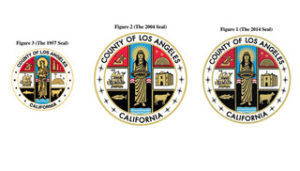Given the United States Supreme Court decision allowing the state of Maryland to keep a cross dedicated to the memory of World War I soldiers on public grounds, should the Los Angeles Board of Supervisors revisit the decision to remove a cross from the county seal? I ask this question in the context of the wider debate of modern sensibilities and the need to understand history.
Recall in 2004, Los Angeles County Supervisors, reacting to a lawsuit from the ACLU, decided to pull the small cross from the county seal. The cross shared a box on the seal with an artistic arc representing the Hollywood Bowl and two stars that stood for the county’s relationship to the movie and television industries.
The ACLU charged that the cross violated the Establishment of Religion Clause in the United States Constitution and must go. The supervisors obliged and made other changes as well removing oil derricks that symbolized the oil industry’s contribution to the county’s growth and the large image of the Roman Goddess Pomona, the keeper of orchids and fruits, standing for the county’s agricultural history. Pomona was replaced by a Native American woman carrying a basket of agricultural goods and the oil derricks were replaced with a drawing of the San Gabriel Mission to recognize the missionary influence in the county, which the now removed cross was also meant to symbolize.
But the mission was missing something—a cross. This didn’t make historical sense so in 2014, the supervisors decided to add a small cross to the depiction of the mission.
Back came the ACLU. The cross supports one religion, a new lawsuit argued, and therefore it is unconstitutional. A federal judge agreed declaring that adding the cross favored Christianity
.
A majority of supervisors chose not to appeal the decision. Had they done so, it might be a case out of Los Angeles County rather than Maryland that would engage the Supreme Court over the symbolism of religion in the country’s history.
For that is what this discussion is really about—not religion, not political correctness—but the recognition of history.
As Justice Samuel Alito noted writing in the Maryland case for a 7-2 majority (many of the justices expressed their own reasons for joining the majority): “As our society becomes more and more religiously diverse, a community may preserve such monuments, symbols, and practices for the sake of their historical significance or their place in a common cultural heritage.”
Alito even brought the history of California place names into his decision stating: “Few would say that California is attempting to convey a religious message by retaining the many city names, like Los Angeles and San Diego, given by the original Spanish settlers. But it would be something else entirely if the State undertook to change those names. Much the same is true about monuments to soldiers who sacrificed their lives for this country more than a century ago.”
The issue of taking away the cross in Maryland that honored long dead soldiers and from the Los Angeles County seal that represented an important piece of how the state developed is part of the discussion spurred by movements to remove statues and cover up paintings, such as the proposal at a San Francisco high school.
But, you cannot change history by painting over it. You can improve conditions by recognizing and acknowledging history.
Perhaps President Calvin Coolidge said it best when speaking, ironically, at the Confederate soldiers memorial at the Arlington National Cemetery.
“It is not for us to forget the past but to remember it, that we may profit by it. But it is gone; we cannot change it. We must put our emphasis on the present and put into effect the lessons the past has taught us.”
We cannot change the past so we must learn from it.

